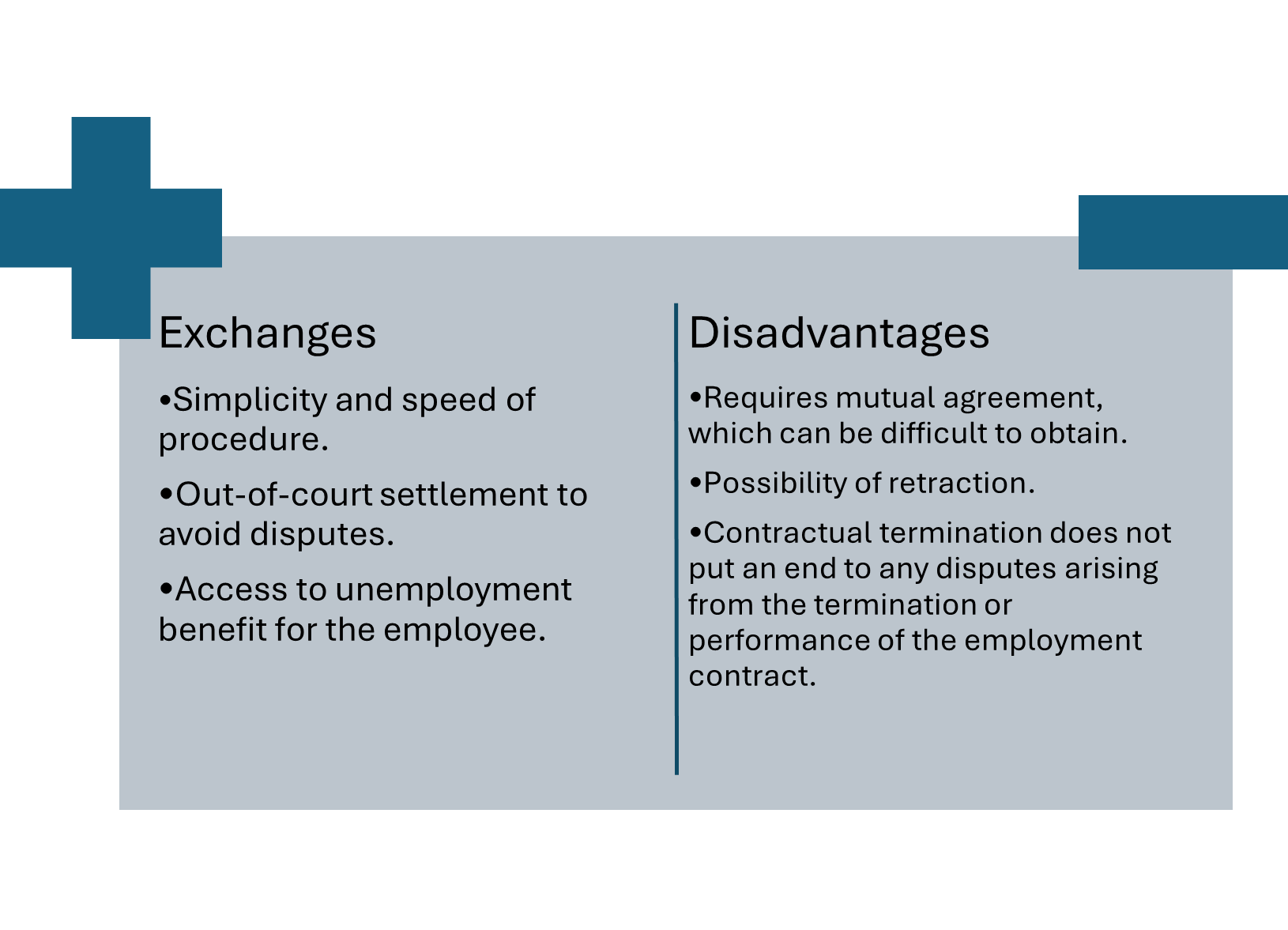Law firm specialising in employment law
and social security law.
Law firm specialising in employment law
and social security law.
Collective redundancy agreements are a way of terminating employment contracts that has now become standard practice in companies, and it is not uncommon to be faced with requests from employees who wish to take advantage of this method of termination, sometimes instead of resigning.
This apparently ‘simple’ method of termination conceals a host of questions and issues at every stage, which should not be overlooked.
Let's take a look at what's involved.
Introduced in 2008 by the Labour Market Modernisation Act, the conventional termination of employment is a method of terminating a permanent employment contract based on an amicable agreement between the employer and the employee. This procedure offers a flexible, consensual alternative to traditional forms of employment contract termination (notably resignation or redundancy).
As with any amicable agreement, however, the conventional termination requires that no defect in consent can be identified and that the consent of the parties is given with full knowledge of the facts.
If the employer's consent is vitiated, the contractual termination is null and void and has the same effect as the employee's resignation. (Cass.soc., 19 June 2024, n°23-10.817)
See our sample timetable and guide to the contractual termination of employment.
The contractual termination may be initiated by the employer or the employee. No particular formalities are required.
First and foremost, the two parties must express their mutual desire to terminate the employment contract, in accordance with article L. 1237-11 of the French Employment Code.
Although a contractual termination may be concluded even in the event of a dispute between the employer and the employee, the Court of Cassation points out that it is still prudent to limit the causes of disputes when signing such an agreement. (Cass. soc., 15 November 2023, n°22-16.957)
Article L. 1237-12 of the French Labour Code stipulates that one or more interviews must be organised to discuss the terms and conditions of the termination (compensation, termination date, etc.).
These meetings allow each party to express its expectations and negotiate the terms of the agreement.
A termination agreement must be drawn up, stipulating the terms and conditions of the termination, in particular the amount of the specific compensation and the termination date. This agreement is set out in a CERFA document published by the TéléRC website (www.telerc.travail.gouv.fr).
The agreement must be signed by both parties, and each party must leave with an original copy.
You can find our model document delivery certificate on the dedicated page.
In accordance with article L.1237-13 of the French Labour Code, each party then has a period of 15 calendar days in which to withdraw from the agreement once it has been signed. Each of the parties may therefore reverse its decision and decide to terminate the procedure, without having to justify its decision. This decision may never be reproached or be the subject of a disciplinary sanction.
Once the withdrawal period has expired, the agreement must be submitted to the Direction régionale de l'économie, de l'emploi, du travail et des solidarités (DREETS) for approval, pursuant to article L. 1237-14 of the French Labour Code.
The authorities have 15 working days in which to approve or reject the request. If there is no response, the application is deemed to have been approved.
If approval is refused by the authorities, the Cour de cassation (French Supreme Court) has ruled that it is possible to regularise the termination agreement in cases where the changes are not substantial. Nevertheless, caution is advised insofar as it is not always possible to rely on such case law when faced with a refusal of approval by the employment authorities. (Cass. Soc., 19 June 2024 n°22-23.143).
Warning! The procedure is different for protected employees, who are subject to a request for authorisation from the labour inspector for the approved termination. Do not hesitate to contact us if you need assistance.
A contractual termination terminates the contract definitively, with no possibility of going back once approval has been obtained.
The employee receives a specific severance payment, which cannot be less than the statutory severance pay or the severance pay provided for in the collective redundancy agreement.
The contractual termination entitles the employee to unemployment benefit, provided he or she meets the eligibility criteria set by France Travail.
Do you have a question? Need to know more? Check out our FAQ on contractual termination, updated with the latest case law and practices accepted by the courts.

The ‘rupture conventionnelle’ is therefore an appropriate solution for ending an employment contract in a calm manner, provided that both parties are able to agree on the terms and conditions. It offers a degree of legal certainty while allowing for a more flexible professional transition.
However, it should be remembered that the ‘rupture conventionnelle’ is not a transaction and that it does not prevent subsequent disputes. For a period of 1 year from the date of approval of the contractual termination agreement, the employee may appeal to a judge to contest the validity of the contractual termination agreement.
However, if the contractual termination agreement is cancelled, the employee must reimburse the specific termination indemnity to the employer. (Cass. soc., 11 October 2023, n°22-12.167)
Still have questions? Do you need assistance? Don't hesitate to contact our teams!